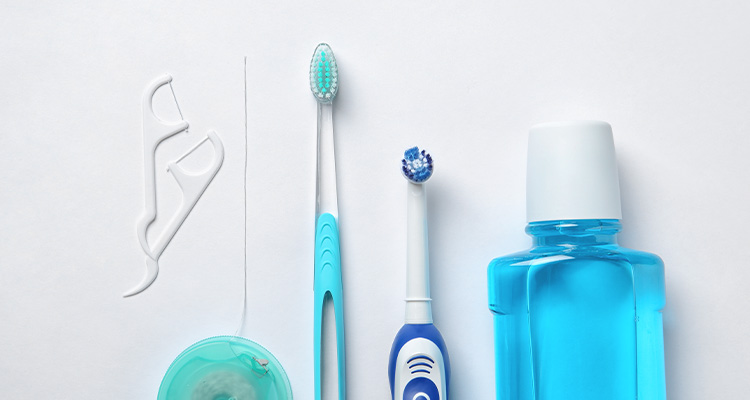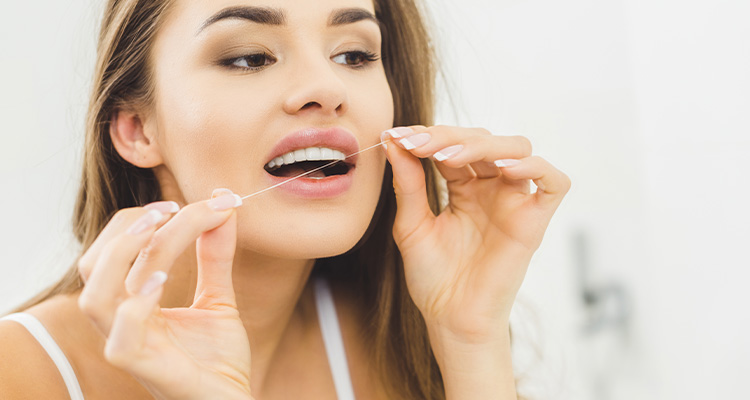Good oral health plays an integral role in your overall health and wellbeing. Good oral health is developed over time by cultivating good daily habits. To help you ensure that your mouth stays happy and healthy here are eight dental health habits you should adopt.
Brushing At Least Twice Per Day
You should be brushing your teeth at least twice per day for a minimum of two minutes at a time. If you can, you should be brushing your teeth after each meal and snack. This helps ensure that the food particles bacteria feed on do not have a chance to remain on your teeth and gums.
When the bacteria in our mouths feed on food particles, particularly sugar, they produce plaque. Plaque causes both gum disease and tooth decay, and if it isn’t removed regularly by brushing and flossing thoroughly, it can harden into tartar. Tartar can only be removed by a dentist or dental hygienist using specialized tools.
Use the Right Tools For the Job
You should always brush with fluoride toothpaste, and select a soft-bristled toothbrush with a small enough head to fit in your mouth comfortably.

You may want to consider investing in an electric toothbrush. Many patients press too hard when using a manual toothbrush, which can damage your teeth and gums over time. Studies have also shown that electric toothbrushes are more effective at removing plaque and preventing gingivitis than manual toothbrushes.
When choosing a toothbrush, toothpaste, mouth wash, or other oral hygiene product make sure you select high-quality products with validated oral health claims.
You should replace your toothbrush every three to four months, or as soon as the bristles become frayed or irregular.
Perfect Your Brushing Technique
When brushing your teeth, you should hold your toothbrush at a slight angle, and focus your efforts on the line between your gums and your teeth. Brush gently using a short back and forth motion.
Take your time, and dedicate approximately thirty seconds to each quadrant of your mouth (upper left, upper right, bottom left, and bottom right) and be sure to brush the inside, outside, and chewing surface of each tooth, as well as the backs of your final set of molars. When you have finished brushing your teeth, you should also brush your tongue. This helps remove plaque, food particles, and other debris.
Brushing Before Flossing
Studies have shown that brushing before flossing, as opposed to brushing after flossing, reduces the amount of plaque that remains between our teeth and helps our teeth retain fluoride. Fluoride makes our teeth more resistant to decay, preventing and even possibly reversing tooth decay.

Flossing At Least Once Per Day
Flossing is an integral part of your daily at-home oral health routine and is essential for removing plaque from hard to reach places – patients who don’t floss miss more than one-third of each tooth’s surface.
You should be flossing at least once per day, or any time something gets stuck between your teeth.
Take Flossing One Tooth at a Time
Proper flossing technique is vital for good oral health. When flossing, slide the floss between your teeth and wrap it around your one tooth to form a “C” shape around the base of your tooth and press it gently under your gum line. Wipe the tooth gently from base to tip two or three times until you have removed all of the plaque.
When flossing, it is important to be gentle. Gently guide the floss between your teeth, and don’t snap the floss down hard between your teeth. Snapping the floss down can hurt your gums, causing them to bleed.
Be Consistent
The best thing you can do for your at-home oral health routine is to be consistent. Make time each day for your oral health. If you have trouble brushing or flossing your teeth speak to your dentist or dental hygienist. They may be able to suggest ways to make brushing and flossing easier.
Products such as pre-threaded flossers, dental picks, water flossers, tiny brushes for cleaning between our teeth, and wooden or silicone plaque removers can make it easier to floss and help improve the efficacy of your flossing technique.
Visit Your Dentist Regularly
A solid at-home oral hygiene routine needs to be paired with regular dental exams and professional cleanings. Regular exams let your dentist identify potential problems, provide you with preventative care, and track changes in your gums, teeth, and overall oral health.
Professional cleanings allow your dental hygienist to remove plaque and look for signs of gum disease, tooth decay, and other potential problems. You should be visiting your dentist for an exam and cleaning every six months, or any time you suspect something might be amiss. Depending on your individual dental needs your dentist may suggest that you visit more frequently.







